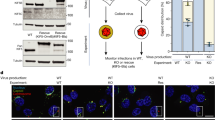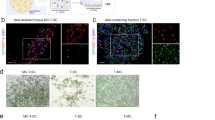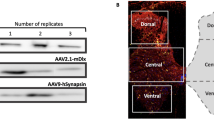Abstract
We have designed a system in which to test gene transfer into gut neurons consisting of an organ culture of neonatal rat small intestine. The tissue was exposed to herpes simplex- and adenovirus-derived vectors: (1) a temperature-sensitive herpes simplex virus-1 (HSV1) vector (tsK-βgal) containing the lacZ gene encoding β-galactosidase (β-gal), under the transcriptional control of the HSV1 immediate–early 3 (IE3) promoter; (2) RAd35, an E1−/E3− replication-deficient adenovirus expressing lacZ under the control of a truncated HCMV major IE promoter; and (3) RAd122, an E1−/E3− replication-deficient adenovirus expressing the lacZ under the control of the RSV LTR. Forty-eight hours after the vector was added to the organ culture, we detected β-gal using immunohistochemistry or X-gal histochemistry in tissue sections examined by light microscopy. We encountered a distinctive staining of cells arranged in two concentric circles corresponding in location to the myenteric and submucosal plexuses. Cells in these areas were of similar size and morphology to neonatal enteric neurons, as visualized by NADPH-diaphorase histochemistry and immunocytochemical staining with antibodies to the neuronally expressed proteins PGP 9.5, or neurofilaments. Double labelling with antibodies recognizing neurofilaments and β-galactosidase revealed that most cells infected by tsK were neurons, while the RAd35 and 122 vectors only infected non-neuronal cells. We thus demonstrate that both HSV1- and adenovirus-derived vectors can be used to transfer genes to the gut in vitro, but they transduce different populations of target cells.
This is a preview of subscription content, access via your institution
Access options
Subscribe to this journal
Receive 12 print issues and online access
$259.00 per year
only $21.58 per issue
Buy this article
- Purchase on Springer Link
- Instant access to full article PDF
Prices may be subject to local taxes which are calculated during checkout
Similar content being viewed by others
Author information
Authors and Affiliations
Rights and permissions
About this article
Cite this article
Brown, O., Santer, R., Shering, A. et al. Gene transfer into enteric neurons of the rat small intestine in organ culture using a replication defective recombinant herpes simplex virus type 1 (HSV1) vector, but not recombinant adenovirus vectors. Gene Ther 4, 331–338 (1997). https://doi.org/10.1038/sj.gt.3300383
Received:
Accepted:
Issue Date:
DOI: https://doi.org/10.1038/sj.gt.3300383
Keywords
This article is cited by
-
Targeting the gastrointestinal tract with viral vectors: state of the art and possible applications in research and therapy
Histochemistry and Cell Biology (2016)



